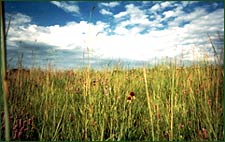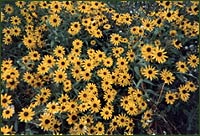|
 Nesting,
Brooding, Loafing and Bedding Cover - Establishing several
variations of native grasses will provide you with all
of the components. Thick native grass stays standing
through the winter for some of the best winter habitat
complimented with your tree plantings. A diverse native
grass stand will provide you with the best nesting and
brooding cover. Again, use your native grass plantings
to connect the tree plantings, food sources and other
habitat areas. Nesting,
Brooding, Loafing and Bedding Cover - Establishing several
variations of native grasses will provide you with all
of the components. Thick native grass stays standing
through the winter for some of the best winter habitat
complimented with your tree plantings. A diverse native
grass stand will provide you with the best nesting and
brooding cover. Again, use your native grass plantings
to connect the tree plantings, food sources and other
habitat areas.
Native sod forming grasses, such as Switch Grass, Canada
Wildrye, Little Bluestem, and Side Oats Gramma, to mention
a few, historically dominated much of the open prairie
between stands of hardwoods. The majority of these grasses
have disappeared with the introduction of development
and agriculture, but are still established in areas
left unsuitable to these activities.
Native vegetation represents a balance between climate,
soil and wildlife that has been replaced by introduced
species such as Smooth Brome, Kentucky Bluegrass, alfalfa
and clover, etc. in areas where established vegetation
cover is needed for controlling soil erosion. While
they establish quickly, introduced vegetation often
deteriorates, especially when planted on poor soils.
Frequently their sod opens up and weeds invade.
Native grasses, because they develop deep root systems
(12 to 15 feet deep), provide very good long term erosion
control. The deep root systems can gain access to nutrients
and moisture that shallow rooted vegetation can not
reach.
Native grasses may establish somewhat slowly. Cover
crops may be needed to provide short-term erosion control
in highly erosive areas while the native vegetation
establishes, otherwise a cover crop is not recommended
to keep competition at a minimum. During the first two
years, native vegetation may appear weedy and unkept
(mowing is recommended). Most of their energy is allocated
to root development during this period but usually reach
maturity by the third year. When native vegetation has
established, there are very few weeds which will be
able to compete for nutrients and water in the soil.
Native vegetation will eventually starve out and hold
out undesirable weeds.
Native vegetation is excellent for wildlife habitat
because of their good winter stability and potential
food sources. They grow tall (up to 4 to 6 feet) with
wire-stiff stems that stay standing through winter,
thereby providing thick, dense cover for pheasants,
deer and other wildlife. It also provides valuable dense
spring nesting cover and protection from predation during
critical time periods. Pocket gophers dislike native
vegetation due to the fact that there are no edible
root systems available as are with clover and alfalfa
and the thick fibrous root systems deter gophers to
easier tunneling elsewhere. The ultimate benefit of
developing native vegetation is that chemical use will
decrease, noxious weed costs will decrease, maintenance
costs will decrease and wildlife and environmental benefits
will improve dramatically.
Some conservation improvements using native vegetation
include: planting native vegetation in areas that were
previously planted with introduced vegetation to reduce
or eliminate pocket gophers and noxious weed problems;
establishing designated nesting areas; establishment
on droughty soils to utilize haying or rotational grazing
on these unproductive soils; developing buffer zones
along wetlands, drainage ways, fence lines or other
field borders. Before wetland restoration projects are
performed, native vegetation can be established near
the estimated water level to ensure noxious weeds will
not be a problem.
PLM promotes establishing native grasses and wildflowers
for development of winter cover and ideal nesting and
brooding cover. Native prairie is proven to starve out
and hold out un- desirable weeds, such as thistles!
Management is made easier due to the reduction of gopher
mounds. Rotational grazing is an option, native grasses
increases average daily weight gain during the mid summer
of traditional cool season grasses.
 Native
prairie is not established well under conventional planting
techniques; however, PLM has been a pioneer in development
of new planting methods to establish faster more successful
native grass stands. With over 150,000 acres established,
PLM is one of the most experienced organizations when
it comes to establishing native prairie. This extensive
experience provides you with the confidence that you
are working with one of the best! Native
prairie is not established well under conventional planting
techniques; however, PLM has been a pioneer in development
of new planting methods to establish faster more successful
native grass stands. With over 150,000 acres established,
PLM is one of the most experienced organizations when
it comes to establishing native prairie. This extensive
experience provides you with the confidence that you
are working with one of the best!
Please contact PLM for further information or free
proposals for projects. We carry an entire line of native
grass seed and wildflower seeds that can be specifically
designed to your liking and your site objectives.
Site Preparation and mowing available also! Call for
free estimates for projects or for technical information.
Periodic burning is an essential part of establishing
and maintaining native prairies. Native prairies often
become "over taken" by woody vegetation and
invasive weeds that may be considered "noxious
weeds". Timely burn suppresses invasive vegetation
while stimulating the native prairie. It is truly remarkable
to see how a prairie responds to fire management you
will see more vigorous native grasses and increased
diversity of wildflowers after a timely prescribed burn!
PLM is fully insured and has several state certified
fire crews to provide prescribed burning services. PLM's
certified fire technicians know and understand fire
behavior and have extensive fire-fighting equipment
on site to assure a safe burning environment.
Native Prairie in a bag is ideally suited for the smaller
landscaping project, lake-scaping, low maintenance lawns,
erosion control, or other areas smaller than one acre.
Each bag of Prairie Mix contains a mix of grasses best
suited for the tall grass or short grass prairie. Add
our special prairie wildflower mix for color. Instructions
for site prep and planting included with each order.
We can also design special mixes to meet your needs.
If you need seed for a larger area contact us for current
prices.

 |
|
Incredible Burn Team
Greetings. I know
from my business that a majority of the responses
we receive from customers are negative. We do
a good job, but few people ever take the time
to say "thank you" and acknowledge a
job well done. I'd like to be one of the few.
PLM and their burn
team waited patiently for the weather to cooperate
before performing our burn. They stayed in close
communication all the while. Last Wednesday was
"the day" and they arrive in the early
afternoon. Armed with the necessary (as well as
needless) paperwork from the City Of Minnetrista
and who knows who else, they diplomatically explained
to the fire department that all was OK.
Cut to the chase:
These folks work hard and long. They are pleasant,
knowledgeable and thorough. This was by far the
best burn we have ever had! They got into every
nook and corner. They stayed until (gulp!) 10:00pm
that night and checked everything the next morning.
They got the attitude,
the skill and the commitment. Great job!
Thanks.
Tim & Susan Clark
9100 West Hill
Rd.
Minnetrista, MN
55388
clark9100@frontiernet.net
|
|